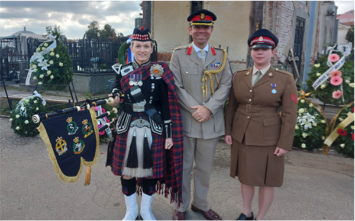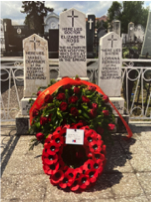
215 (Scottish) Multi-Role Medical Regiment (MMR) and 254 (East of England) MMR personnel travelled to Serbia to attend the Balkans Nursing Conference and Commemoration Ceremony.
The 12-15 February event saw members of the Army Medical Services (AMS) visit the Conference and take part in the Scottish Women’s Hospital (SWH) World War One Commemoration Service alongside members of the Serbian Armed Forces, the Red Cross, foreign ambassadors and local dignitaries (pictured above).
The bilateral event took place at the Belgrade Military Medical Academy, as well as memorial sites in Kragujevac, and formed an important part of ongoing engagement with the Serbian Ministry of Defence.
Key objectives of the exercise were to continue positive diplomatic relations, develop a shared understanding of operational healthcare in complex and unique environments, and to commemorate the lives of doctors and nurses from the Scottish Women’s Hospitals who served the Serbian people during World War One.
The attendees were Captain Pounder, Nursing Officer, 215 (Scottish) MMR; and Corporal Newton, Nursing NCO, 254 (East of England) MMR.
This was the Unit’s second visit to Belgrade. They have developed a great relationship with the team there and hosted the Serbian 1* on his recent visit to 2 Medical Brigade in York. They are aiming to conduct Adventurous Training in Serbia in September to reinforce that relationship.
⚫️ The SWH organisation was founded by Dr Elsie Inglis. Following the outbreak of war in August 1914, she offered her services to the Royal Army Medical Corps (RAMC) at Edinburgh Castle and was famously told: “My good lady go home and sit still.”
Paying no heed, Dr Inglis used her links within the Suffrage movement to raise funds to establish the first Scottish Women’s Hospital in France. Further hospitals in Serbia, Salonica, Romania, Corsica and Russia soon followed.
All of the administrators, nurses, surgeons, bacteriologists, cooks, engineers, drivers and orderlies were women. They worked at the front line from November 1914 until the end of the war. The hospitals were well regarded and many of these women were awarded medals by the host countries for their skills in caring for the sick and wounded.
Each year on 14 February, the local people of Kragujevac hold a commemoration at the graves of Dr Elizabeth Ross, Nurse Mabel Dearmer and Nurse Lorna Ferriss. These three women worked in the local Scottish Women’s Hospital and lost their lives whilst treating Serbian casualties and victims of a catastrophic typhus epidemic.
In 1977, the local Red Cross in Kragujevac restored their graves. Dr Ross’ name, in particular, has become synonymous with courage and bravery, with a street being named after her and the youth movement of the local Red Cross re-titled the Dr Elizabeth Ross Society. These young people, along with local dignitaries, join in the commemoration and wreath laying service each year.










